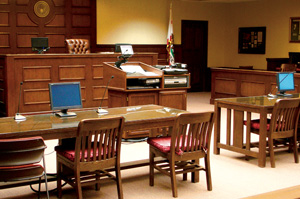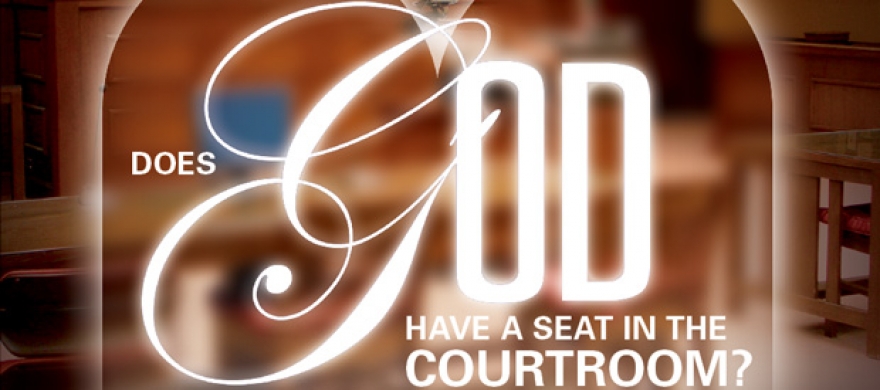Watch video footage and learn more about the conference topics and speakers in this iTunesU video.
Sandra Fluke’s February testimony before an all-Democratic panel placed the Georgetown law school student at the top of news headlines across the country.
The 30-year-old former president of the Georgetown Law Students for Reproductive Justice argued in support of President Obama’s health care regulation that would obligate all insurance plans, including those offered by the Catholic university, to cover sterilizations and all FDA-approved contraceptives.
With the testimony came a whirlwind of response, ranging from public support and scrutiny, to on-air name-calling from Rush Limbaugh. Throughout the spring, the story has continued, and the debate remains: when, if ever, should law and religion overlap?
“The problem is that there isn’t an understanding among the general public of the heart of the issue,” said Michael Peabody (JD ’01), an employment attorney with Bradford & Barthel, LLP in Tarzana, California. “These issues become heated conflicts. When they hit the news, people become angry. They feel that their way of life is being threatened. But the issue is really a question of understanding law and religion as separate entities. It’s not an individual-focused debate. It’s one facing our society as a whole.”
 To address that and additional topics, Pepperdine convened more than 80 expert panelists
for a religious legal theory conference sponsored by the School of Law’s Herbert and
Elinor Nootbaar Institute on Law, Religion, and Ethics, and the University's Diane
and Guilford Glazer Institute for Jewish Studies. “Competing Claims of Law and Religion:
Who Should Influence Whom?” was held at the School of Law from February 23 to 25.
To address that and additional topics, Pepperdine convened more than 80 expert panelists
for a religious legal theory conference sponsored by the School of Law’s Herbert and
Elinor Nootbaar Institute on Law, Religion, and Ethics, and the University's Diane
and Guilford Glazer Institute for Jewish Studies. “Competing Claims of Law and Religion:
Who Should Influence Whom?” was held at the School of Law from February 23 to 25.
The conference, which tackled a host of sub-questions, all at the forefront of contemporary debates over the respective roles of law and religion, was the largest religious and legal theory conference hosted by Pepperdine. Topics included constitutional law, good citizenship, and matters of religious faith.
“We had people approaching each conference topic from most major angles: conservative, liberal, Christian, Muslim, Jewish, secular, feminist, and multicultural,” said Robert Cochran, Louis D. Brandeis Professor of Law, and director of the Nootbaar Institute. “Many feel that we are in a time of transition as to the question of law and religion, and no one knows where we will wind up. In my view, the conference was a success because people from almost every perspective were listening to one another.”
As the conference demonstrated, the conversation surrounding the recent proposed health care regulation isn’t a unique one. Examples abound in daily life about the intersection between law and religion in society.
TAKE CASE ONE.
A religious symbol is displayed on a government-owned structure. The reasoning, according to those employed at that particular building, is to simply show support of the majority population within the community. Secular residents, however, become outraged and seek legal action. The story leads the five o’clock news.
CASE TWO.
A public school student returns home at the end of the day. The student’s parent asks how the day went. In recounting the day’s activities, the student mentions a prayer said in class. The parent is against the idea of prayer in a public school. The parent seeks legal counsel against the school. A court case ensues.
In each case, the complex debate of how, or even if, law and religion should combine reenters the scene.
Peabody, who was led back to the Malibu campus for the conference because of his scholarship on the relationship between religion and law, maintains a blog that discusses the application of the Free Exercise and Establishment Clauses of the First Amendment. The topic was the focus of one of the conferences breakout sessions titled “Government Institutions, Religious Affairs, and the First Amendment.”
In a January 29, 2012 post, Peabody discussed the issue on his blog, ReligiousLiberty.TV. The case was Hosanna-Tabor v. EEOC (Equal Opportunity Employment Commission), which was decided by the U.S. Supreme Court just weeks before on January 11.
In that case, Cheryl Perich was a fourth-grade teacher at a Lutheran church school in Michigan. In addition to teaching both secular and religious subjects, Perich also performed ministerial functions.
She went on medical leave and, upon returning to the school, Perich threatened to file a lawsuit under the Americans with Disabilities Act when she learned that she would not be getting her teaching job back. Church officials stood by their decision, knowing that those holding ministerial positions are barred from filing a lawsuit against the church. The judge ruled in favor of the church, citing the Establishment and Free Exercise Clauses of the First Amendment, and the protection of the church’s decision under the clauses.
“The ministerial exception gives religious institutions certain rights to control employment matters without interference from the secular courts,” Peabody wrote. “It does not, as the court decision points out, affect criminal, tort, or contract law. So churches cannot use it to shield themselves from liability for criminal acts, negligent behavior leading to accidents, or breach of contract. But it does protect churches from being hauled into court for religious decisions that have been made.”
As was the case with the proposed regulation of contraceptives, Perich’s case is the not the first of its kind, nor is it the first time a church has been questioned for what, to some, seems like a discriminatory decision.
“It’s similar to cases where a woman applies to become a priest or a rabbi, but the congregation turns her down because she is a woman,” said Michael Helfand, associate professor of law at the Pepperdine School of Law, and associate director of the Diane and Guilford Glazer Institute for Jewish Studies. “For other companies or organizations, that is a clear violation of Title VII. But where it is the rule of the church, churches are protected in making those types of decisions.”
“Two Theories of Religious Accommodation,” one of four plenary sessions at this year’s conference, focused on the clash of religious accommodation, gender equality, and individual identity. Panelist Ayelet Shachar, professor of law and Canada Research Chair in Citizenship and Multiculturalism at the University of Toronto, was among four panelists who highlighted the interaction between religious and secular sources.
In arguing in favor of fair inclusion in religion and against excluding individuals, specifically because of gender, Shachar said, “I want to suggest that, in part, the reason I am concerned about exclusionary diversity is because it captures some of the more conservative elements within religious communities—some of the more rigid interpretations of religious identity and, of course, of the rich traditions which have a vast array of interpretations. But typically the exclusionary diversity comes from the more conservative, and I would even want to say the more extreme, interpretations of these religions. If we allow these communities, or these subsets within the communities, binding authority over members, I am quite concerned with the rights of women specifically in this context.”
“Ayelet Shachar’s work continues to provide important insights into how a liberal democratic state can simultaneously protect the religious commitments of its citizens without undermining other fundamental liberties,” Helfand noted.
According to Peabody, religious liberties and the guarding of the rights of members of protected classes against discrimination, including gender, are an essential element of law in the United States.
“What a person believes about religion is their operating system,” he said. “It determines their outlook on the world. It’s important to protect the rights of someone’s beliefs as long as they aren’t adversely affecting others.”
With that, Peabody referenced the argument of including the Ten Commandments in the courtroom.
“The suggestion is that if a person is arrested in California, they should have the symbol of the State of California alongside the Ten Commandments,” he said. “But each represents its own complete legal system. As Christians, we are taught that if we plead guilty under the Ten Commandments, then God will forgive us. But in a courtroom, a judge may still throw the book at you. Incorporating both legal systems on a courtroom wall sends a mixed message and waters down what religion really means.”
In the end, Peabody believes, it’s a matter of the government’s need to stay neutral.
“We can’t marginalize individuals because of belief or nonbelief,” he said. “It’s the concept that people have to let God be God.”
